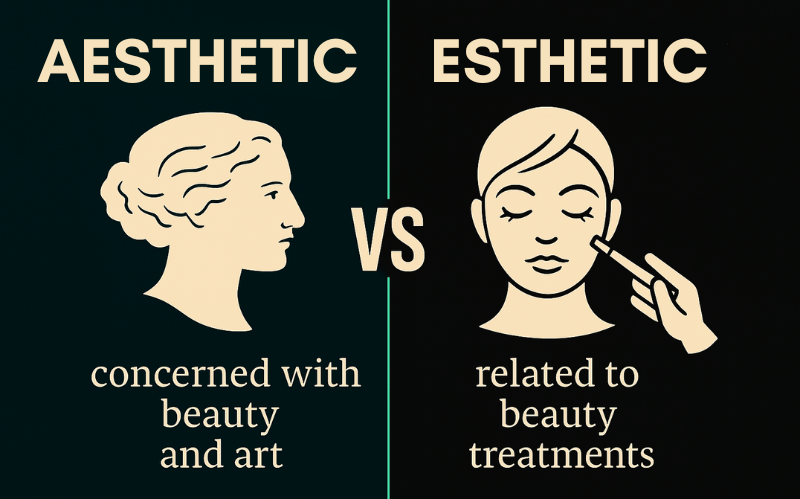

Have you ever paused to wonder about the difference between esthetic and aesthetic? These two terms, often spelled differently yet sounding the same, can spark curiosity among language lovers and beauty enthusiasts alike. Whether you’re exploring the beauty industry, pondering a philosophical question, or training to become an esthetician, understanding esthetic versus aesthetic is key to using them correctly. Let’s dive into their meanings, uses, and contexts to clear up the confusion once and for all!
Table of Contents
ToggleDefining the Terms: Esthetic and Aesthetic
At their core, both esthetic and aesthetic stem from the Greek word aisthētikos, meaning perceptive or pleasing to the senses. They function as an adjective describing beauty or the appreciation of it, but their usage varies slightly:
- Aesthetic is the more common spelling in the English language. It relates to beauty, art, or a set of principles guiding creative expression. For example, you might admire "the aesthetic charm of a modern painting" or discuss a film’s unique aesthetic for art’s sake.
- Esthetic is a variant spelling, often tied to American English. While it shares the same meaning as aesthetic, it’s frequently used in the beauty industry to describe practical applications of beauty, like skin treatments or body treatments.
As a noun, the terms shift slightly:
- Aesthetics refers to the branch of philosophy concerned with beauty and taste. It’s the philosophical study of what makes something beautiful, asking questions like, "What defines art?"
- Esthetics typically points to the beauty industry, focusing on skincare, makeup application, and cosmetic services.
So, while aesthetic and esthetic are nearly synonymous, their contexts—philosophy versus practice—set them apart.
Usage in Everyday Language
In general writing, aesthetic reigns supreme. You’re more likely to see it in phrases like “the room’s aesthetic vibe” or “her personal style has a bold aesthetic.” Esthetic, though correct, is less common outside specific fields and might feel like a stylistic choice in British English or elsewhere.
The spelling difference is subtle, but sticking with aesthetic in casual or artistic discussions keeps things simple and widely understood.
Esthetic vs. Aesthetic in the Beauty Industry
Here’s where the beauty industry sharpens the distinction. If you’ve ever visited a spa or salon, you’ve likely encountered an esthetician—a specialist in skin care. These licensed skin care specialists provide services like facials, wax, laser hair removal, and chemical peels. In American English, “esthetician” is the standard term, reflecting the field of esthetics, which covers beauty treatments such as microdermabrasion, microblading, and aromatherapy.
But what about aesthetician? While some use it interchangeably, aestheticians are more commonly referenced in British English or in contexts like medical aesthetics, where professionals might offer injections (e.g., Botox or filler), skin resurfacing, or paramedical care alongside dermatologists. In the U.S., however, estheticians focus on beneficial cosmetic services rather than medical procedures.
Esthetics in this realm is all about hands-on care—think massage, peel treatments, or addressing complex skin conditions like acne. Meanwhile, aesthetics might inspire the ambiance of a salon or spa, but it’s less about the practical work.
For example:
- An esthetician at a spa might perform a facial to improve skin health.
- An aesthetician in a medical aesthetics setting could administer skin care treatments like botox with advanced training.
Despite these nuances, estheticians and aestheticians often overlap in their mission to enhance beauty through skin treatments.
Practical Tips: When to Use Each Term
So, what’s the difference in usage? Here’s your guide:
- Aesthetic: Use it for art, design, or general beauty discussions. Example: "The aesthetic of the gallery was breathtaking."
- Esthetic: Opt for it in beauty services or U.S.-based cosmetology contexts. Example: "The esthetic techniques at the salon transformed my skin type."
- British English: Stick to aesthetic or aesthetician across the board.
- American English: Lean toward esthetic and esthetician for work in beauty.
Consistency matters—choose one and stay with it unless you’re highlighting the aesthetic and esthetic divide intentionally.
Esthetics vs. Aesthetics: A Closer Look
The noun forms deepen the story:
- Aesthetics refers to the branch of philosophy that deals with beauty’s nature. It’s abstract, exploring how we perceive art or nature’s pleasing to the senses qualities.
- Esthetics refers to the cosmetology program or training at a cosmetology school, where estheticians learn to treat patients with skin conditions using beauty treatments.
Choosing a website builder, between Webflow or Squarespace, to create a website that promotes your brand becomes difficult. Let’s get to know the pros and cons of that website builder. Webflow is a website builder that has both pros and cons. Let’s discuss it one by one.
For instance:
- "Her lecture on aesthetics reshaped my view of beauty."
- "The esthetics course taught me how to perform hair removal."
Both esthetics and aesthetics connect to beauty, but one’s a philosophy concerned with theory, the other a practical craft.
Common Questions Answered
Let’s tackle some FAQs:
- Are aesthetic or esthetic interchangeable? Yes, technically, but context is king. Aesthetic fits art; esthetic suits skincare.
- Aesthetician and an esthetician—what’s the difference? Mostly regional—esthetician is U.S.-preferred, while aesthetician pops up elsewhere or in medical aestheticians roles.
- Aesthetics and esthetics—same thing? Not quite. Aesthetics is philosophical; esthetics is industry-focused.
The Beauty Industry in Action
Estheticians thrive in diverse settings—salons, spas, or medical aesthetics clinics. They might provide services like skin resurfacing, chemical peels, or body treatments, requiring interpersonal skills to connect with clients. Some pursue advanced training in microblading or makeup artists techniques, while others team up with dermatologists to tackle skin conditions.
Aspiring pros attend a cosmetology school, mastering state regulations and skin care skills in a supportive work environment. Their work is both art and science, blending aesthetic inspiration with esthetic expertise.
Wrapping Up: Esthetic or Aesthetic?
Whether you’re drawn to the aesthetic allure of a sunset or the esthetic mastery of a facial, these terms enrich our understanding of beauty. Rooted in a derived from the Greek origin, they remind us beauty is both perceptive and practical. So next time you’re at a salon or spa, chatting about skin health or admiring decor, you’ll know exactly which word to use—and why!

Waleed Dad Khan
Waleed Daad Khan has over half a decade of experience in digital marketing, working with a wide range of law firms to optimize their internet marketing strategies. Having worked on numerous successful campaigns, Waleed holds various certifications in digital Marketing, which helps him craft strategies tailored specifically for the legal sector.

